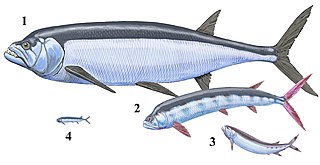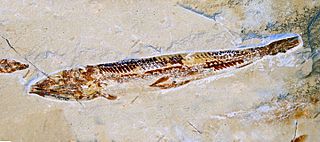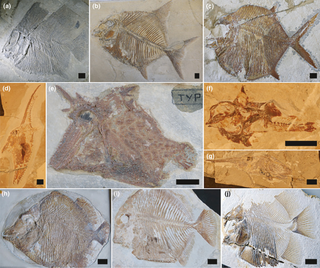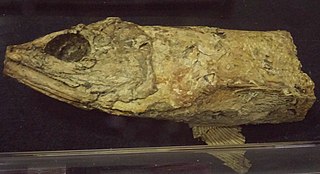Ophidiiformes is an order of ray-finned fish that includes the cusk-eels, pearlfishes, viviparous brotulas, and others. Members of this order have small heads and long slender bodies. They have either smooth scales or no scales, a long dorsal fin and an anal fin that typically runs into the caudal fin. They mostly come from the tropics and subtropics, and live in both freshwater and marine habitats, including abyssal depths. They have adopted a range of feeding methods and lifestyles, including parasitism. The majority are egg-laying, but some are viviparous.

The Myctophiformes are an order of ray-finned fishes consisting of two families of deep-sea marine fish, most notably the highly abundant lanternfishes (Myctophidae). The blackchins (Neoscopelidae) contain six species in three genera, while the bulk of the family belongs to the Myctophidae, with over 30 genera and some 252 species.

Ichthyodectiformes is an extinct order of marine stem-teleost ray-finned fish. The order is named after the genus Ichthyodectes, established by Edward Drinker Cope in 1870. Ichthyodectiforms are usually considered to be some of the closest relatives of the teleost crown group.

Cimolichthys is an extinct genus of large predatory marine aulopiform ray-finned fish known worldwide from the Late Cretaceous. It is the only member of the family Cimolichthyidae.

Acanthomorpha is an extraordinarily diverse taxon of teleost fishes with spiny fin rays. The clade contains about one-third of the world's modern species of vertebrates: over 14,000 species.

Apateodus is a genus of prehistoric marine ray-finned fish which was described by Woodward in 1901. It was a relative of modern lizardfish and lancetfish in the order Aulopiformes, and one of a number of prominent nektonic aulopiforms of Cretaceous marine ecosystems.

Prionolepis is a genus of prehistoric ray-finned fish belonging to the order Alepisauriformes.

Bananogmius is an extinct genus of marine ray-finned fish that was found in what is now North America and Europe during the Late Cretaceous, from the Cenomanian to the Santonian. It lived in the Western Interior Seaway, which split North America in two during the Late Cretaceous, as well as the proto-North Sea of Europe.

Pycnodontiformes is an extinct order of primarily marine bony fish. The group first appeared during the Late Triassic and disappeared during the Eocene. The group has been found in rock formations in Africa, Asia, Europe, North and South America.

Enchelion is an extinct genus of prehistoric marine ray-finned fish that lived during the Late Cretaceous. It contains a single species, E. montium known from the upper Cenomanian of the Haqel locality of the Sannine Formation in Lebanon. It is the only member of the family Encheliidae.

Aphanepygus is an extinct genus of prehistoric marine holostean ray-finned fish that lived during the upper Cenomanian. It inhabited the former Tethys Ocean, with remains known from Lebanon and Croatia. Its exact affinities are uncertain, although it is usually recovered as a relative of the macrosemiids. However, other authorities recover it in the Ionoscopiformes.
Ctenocephalichthys is an extinct genus of prehistoric marine ray-finned fish, generally considered a holocentriform, that lived during the Late Cretaceous. It is known from Cenomanian to the Santonian of Lebanon.
Enchelurus is an extinct genus of prehistoric marine ray-finned fish that lived during the Late Cretaceous. It contains three species, known from the Cenomanian to Campanian of Europe and the Middle East.

Anomoeodus is an extinct genus of prehistoric marine ray-finned fish belonging to the family Pycnodontidae. This genus primarily lived during the mid-to-late Cretaceous period, ranging from the Albian to the very end of the Maastrichtian age, and possibly into the Danian. The first fossils of Anomoeodus were described by Louis Agassiz in 1833, although they were described under Pycnodus. Some studies have recovered it as a wastebasket taxon.

Ctenothrissa is a prehistoric genus of marine ray-finned fish in the order Ctenothrissiformes. It contains a number of species known from the Late Cretaceous of England and Lebanon.

The Sannine Formation, also called the Sannine Limestone, is a Cretaceous geologic formation in Lebanon. It is a Konservat-Lagerstätte that contains a high diversity of well-preserved fish, reptiles, and invertebrates from the Tethys Ocean within its three main localities: Haqel, Hjoula, and Nammoura.

Goulmimichthys is an extinct genus of ray-finned fishes in the family Pachyrhizodontidae. The genus, first described by Cavin in 1995, is known from various Turonian age formations. The type species G. arambourgi from the Akrabou Formation in the El Rachidia Province of Morocco, and other fossils described are G. gasparini of the La Frontera Formation, Colombia, and G. roberti from the Agua Nueva Formation of Mexico.

Tselfatiiformes is an extinct order of bony fishes from the infraclass Teleostei. The order represents the most important radiation of marine teleosts during the Cretaceous period. Fossils of tselfatiiforms are known from Europe, North America, central and northern South America, the Middle East and North Africa.

The Ellimmichthyiformes, also known as double-armored herrings, are an extinct order of ray-finned fish known from the Early Cretaceous to the Oligocene. They were the sister group to the extant true herrings, shad and anchovies in the order Clupeiformes, with both orders belonging to the suborder Clupeomorpha.

The Dercetidae are an extinct family of aulopiform ray-finned fish that are known from the Late Cretaceous to the early Paleocene. They are among the many members of the diverse, extinct suborder Enchodontoidei, which were dominant during the Cretaceous.

















